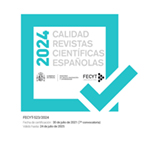Indigenous Territoriality and State Expansion in the Buenos Aires Frontier (Second Half of the 19th Century): Between Official Speech and Material Reality
Abstract
Within the framework of the study of the process of state and Creole expansion towards the south of Buenos Aires county during the 19th century, we analyze indigenous mobility and territoriality, as well as its interaction with other border agents. We follow a multidisciplinary approach focused in Azul, Tapalqué and Olavarría, that constituted the nucleus of the «indios amigos» settlements until the end of the century. Through the intensive use of a varied range of documentary sources (registers and censuses of population, earth measurements, cartographic material, traveler stories, official letters, etc.) complemented with the analysis of the archaeological record, the work shows the lapses and limitations of the official sources opposite to the material reality. Besides, bearing in mind the regional and temporary specificities of the case studied, we rescue «illiterate» people like active agents of the contemporary historical processes.Downloads
Article download
License
In order to support the global exchange of knowledge, the journal Revista Española de Antropología Americana is allowing unrestricted access to its content as from its publication in this electronic edition, and as such it is an open-access journal. The originals published in this journal are the property of the Complutense University of Madrid and any reproduction thereof in full or in part must cite the source. All content is distributed under a Creative Commons Attribution 4.0 use and distribution licence (CC BY 4.0). This circumstance must be expressly stated in these terms where necessary. You can view the summary and the complete legal text of the licence.









